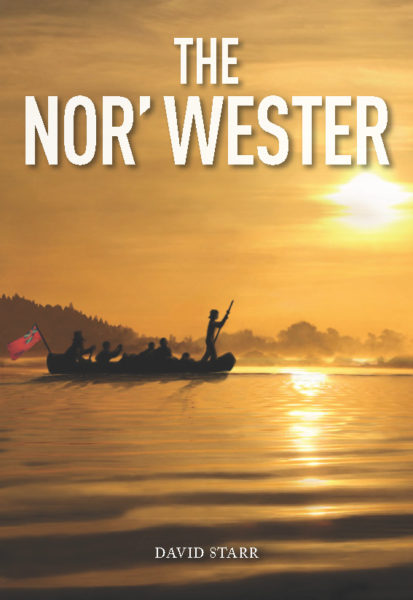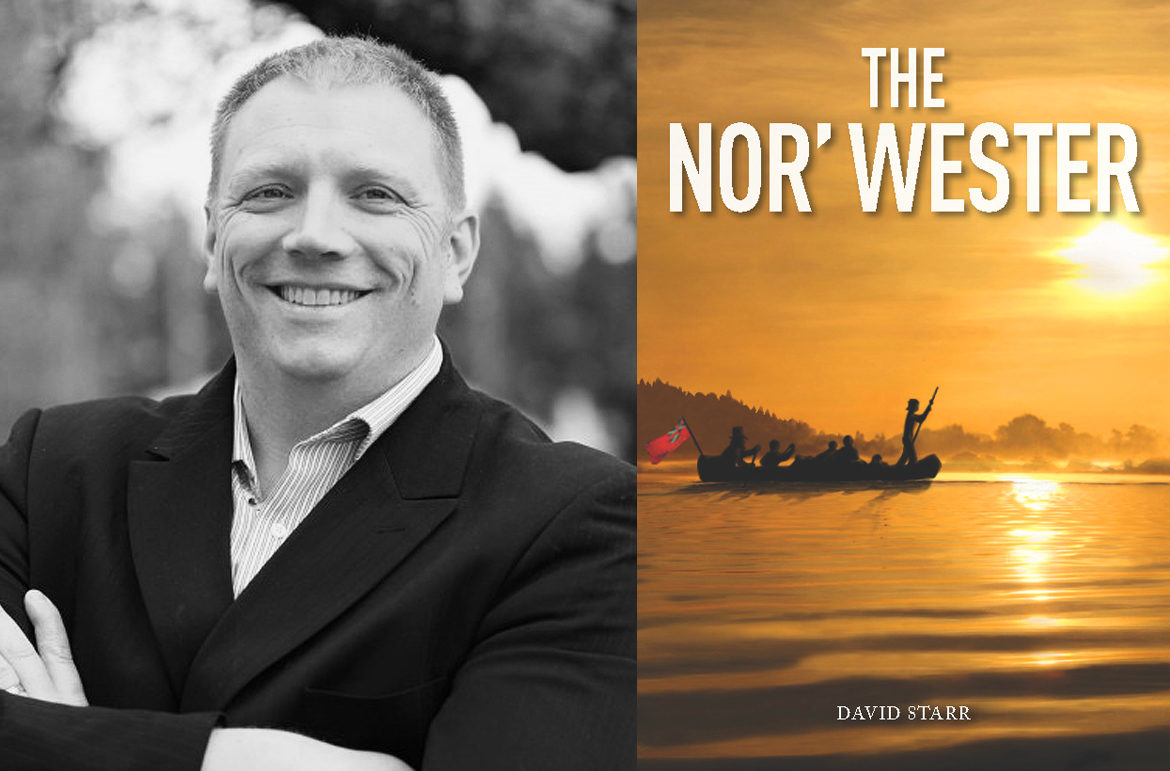David Starr’s young adult novel, The Nor’wester, is a retelling of Simon Fraser’s journey in the Pacific Northwest, as seen through the eyes of a young boy. Historian Stephen Hume said it was “dramatic, compelling, filled with action and will be a treat for readers young and old.” We sat down with David to talk about his book, the historical research, and more.
Q: This is probably one of the most common questions, but where did you get the idea for your book?
I started work on The Nor’Wester nearly 20 years ago when I was teaching grade 10 social studies. A significant part of the curriculum was Canada in the 19th century, and while I really enjoyed the time period, a source of frustration for me was that there was little in the way of supplementary resources to engage students. I have always used historical fiction to spice up my teaching. There was nothing on the market that I found engaging so I thought maybe I could write one.
The Nor’wester is the sort of book I wish had existed when I was teaching for this age level: it covers some absolutely fascinating aspects of our history: the fur trade, early immigration to Canada, the complicated relationship between the Indigenous people and the European explorers – all seen through the eyes of a teenager.
The other piece for me is that I was raised in Fort St. James, the capital of New Caledonia and a key locale in the novel. FSJ was established by Simon Fraser more than 200 years ago. I grew up with the history of the place, and it always surprises me that so many people in the province didn’t know about either the town or its key role in the history of BC it has played. The book was an homage of sorts to my hometown as well.
Q: What kind of research did you do for your book?
I think I spent more time researching than writing! As a historian and teacher of history being historically accurate is important to me. I used multiple sources preparing to write this book. The Letters and Journals of Simon Fraser 1806–1808, edited by W. Kaye Lamb, was a critical source. I actually used some of Fraser’s journal entries as dialogue in the novel. Stephen Hume’s Simon Fraser: In Search of Modern British Columbia was tremendously important to the book as well.
I also spent a great deal of time online researching everything from the Highland Clearances, the coffin ships that took immigrants across the Atlantic, the history of the North West Company as well as that of the Métis, and that of the Indigenous peoples of Canada. That said I did take some liberties with events and timelines for the purpose of the story, but when I strayed from actual events I acknowledge that in the book.
Q: What is your favourite aspect of the book, and why?
I think that one of the things I’m proud of is capturing the complexity and conflict that existed in the time period. Conflict between the Scots and the English, between the French and the English, the USA and the British Empire, and perhaps most importantly, the complicated and conflicted relationship between the Indigenous people of what became British Columbia and the early Europeans who came west of the Rockies in the name of Crown and Company.
Fraser, my protagonist Duncan Scott, and the rest of the Nor’Westers are British subjects. They possess the confidence (one could say arrogance) of being part of the Empire. Yet at the same time they find themselves alone in a wild place, far from home, utterly dependent on the Indigenous people they meet for food, clothing, directions, even their very lives. It is a humbling, conflicted thing for them and I try to present that.
Q: What was the hardest scene to write in The Nor’wester, and why?
I don’t know if there was one particular scene I found more difficult than any other, but throughout the book I worked hard to endure I was presenting the Indigenous characters, their dialogue and their interaction with the Europeans in a way that honoured their own languages, names and histories. I wanted to avoid tokenism, stereotypes, or cultural appropriation. I also wanted to deal with the uncomfortable truth that good intentions or otherwise, Fraser’s journey down the river was one of the first steps towards a massive cultural dislocation in British Columbia—one that would lead to subjugation, assimilation, and the near extinction of many Indigenous cultures and peoples. The scene where Duncan and Fraser return to Kumsheen to discover that an illness has swept through the community, for example, addresses this.
Q: How do you decide on the traits and characteristics for your characters? Do any of the characters resemble you?
Flawed, imperfect characters are much more entertaining to watch and read, and thankfully our history is full of them. Fraser’s character in the book is based on research about what the man was like. My antagonist, the voyageur La Malice as well as the voyageur Waccan were real people from the period as well, men whose temperaments are in the historical record. I really enjoyed creating Duncan Scott as well. He is kind, loyal, hardworking and brave, but he is also rash and impetuous, with a bit of fiery temper that creates many of the situations he finds himself in – personally, I can relate to some of Duncan’s flaws. I also tried to show good and bad, right and wrong strength and imperfections within each of my characters, to give them life and depth.
Q: If you could live in one historical period what would it be, and why?
I’m working on an adult historical fiction right now set in the time of the Seventh Crusade so right now that’s the time I’m most fascinated with.
Q: Do you have a book recommendation to share?
Right now I am reading Wizard and Glass, the fourth book in Stephen King’s Dark Tower Series. I am a huge King fan; the way he creates dark, deeply compelling characters in whatever genre he is working in sets him apart from any other modern writer. He is a master.
I also recently completed Dead Wake, the story of the last crossing of the Lusitania by Erik Larson. It’s a fantastic read and I highly recommend it.
Q: What’s your next project?
I have been very fortunate to work with three outstanding Canadian publishers and I have upcoming projects with all of them. The sequel to The Nor’wester is nearly complete and is with Ronsdale Press. Ronsdale is also considering an adult historical fiction novel set in the time of the Second Sudanese Civil War.
Lorimer will release the sequel to Golden Goal, my YA sports book, in August, and Insider’s Guide to K-12 Education in British Columbia, a parent resource I co-wrote with two other educators for Pacific Education Press (now in the hands of UBC Press) will be serialized in the Chinese language paper and website WC Weekly in the very near future.
As I mentioned earlier I am also working on a historical fiction for adults set in the 1240s at the time of the ill-fated Seventh Crusade. This book is a “Pillars of the Earth/Game of Thrones/Excalibur” mashup that has been tremendously enjoyable to write. I’m a few months away from finishing.
 The Nor’wester by David Starr (Ronsdale Press) is a gripping novel for young readers beginning in 1805, when fifteen-year-old Duncan Scott and his sister Libby lose their parents in a Glasgow cotton mill fire. After fleeing Scotland as well as England, Duncan finds himself in Canada, where he is enlisted to travel by canoe across the continent to New Caledonia, carrying secret orders for the trader, Simon Fraser. Before he can go home and find Libby, Duncan must join Fraser on a dangerous voyage of discovery to the Pacific Ocean, a journey down what Fraser assumes is the Columbia River. Along the way, Duncan faces death, danger and treason, and must somehow find the courage to save his companions, the expedition, and himself.
The Nor’wester by David Starr (Ronsdale Press) is a gripping novel for young readers beginning in 1805, when fifteen-year-old Duncan Scott and his sister Libby lose their parents in a Glasgow cotton mill fire. After fleeing Scotland as well as England, Duncan finds himself in Canada, where he is enlisted to travel by canoe across the continent to New Caledonia, carrying secret orders for the trader, Simon Fraser. Before he can go home and find Libby, Duncan must join Fraser on a dangerous voyage of discovery to the Pacific Ocean, a journey down what Fraser assumes is the Columbia River. Along the way, Duncan faces death, danger and treason, and must somehow find the courage to save his companions, the expedition, and himself.
David Starr is a prize-winning author of three previous books. In Bombs to Books, he chronicled the stories of refugee children and their families coming to BC. Golden Goal is a young adult soccer-themed book for reluctant readers. The Insider’s Guide to K–12 Education in BC is a resource guide for parents about the BC school system. David grew up in Fort St. James, a town that plays a large role in The Nor’Wester. He now lives in Coquitlam with his wife, four children and a dog named Buster. He combines the roles of high school principal and author.

